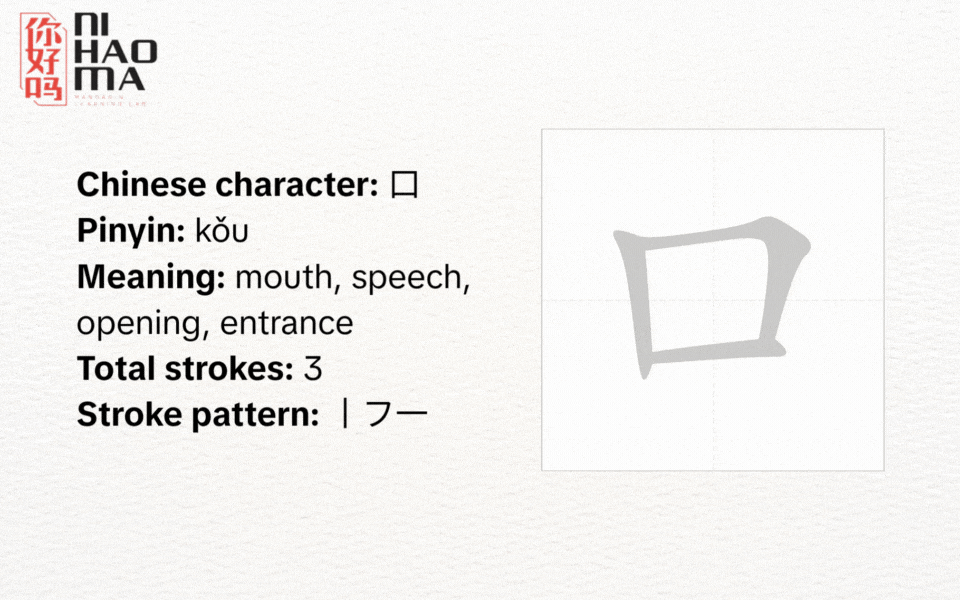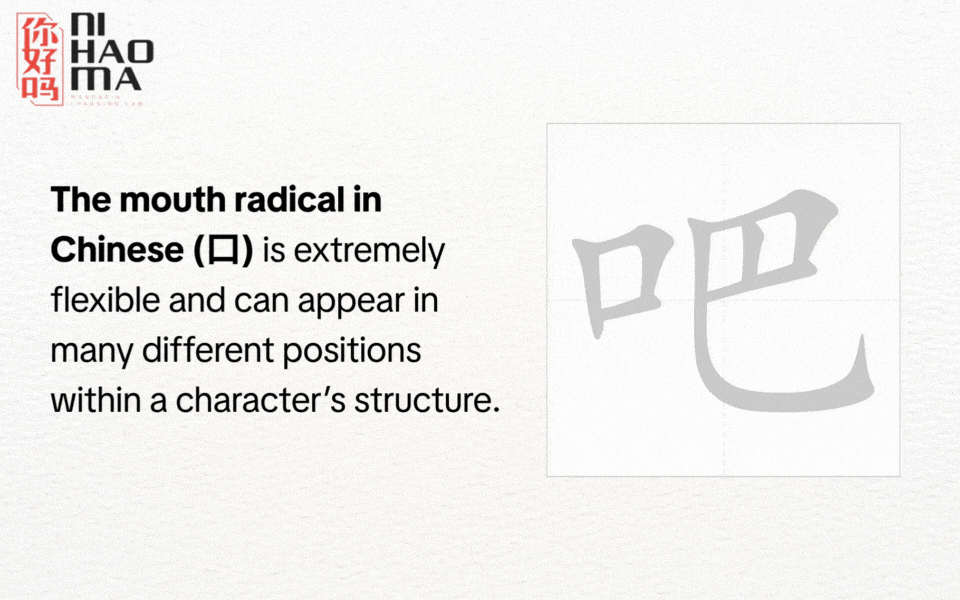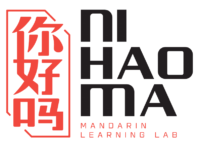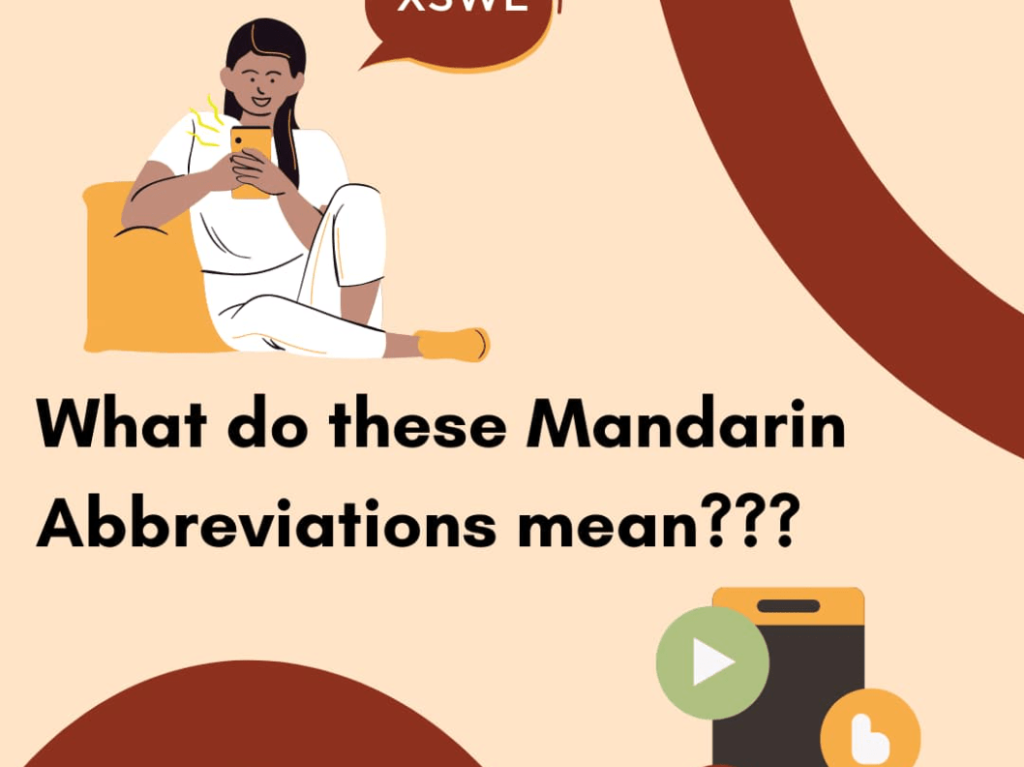During your journey of learning Chinese characters, you’ve probably come across the mouth radical in Chinese many times – one of the most frequently used radicals in the entire writing system. This radical is directly connected to speech, sound, eating, and actions performed by the mouth, and it appears in a wide range of everyday vocabulary. In this guide, we’ll explore its meaning, how to write it correctly, and some common characters that use the mouth radical.
What Is the Mouth Radical in Chinese?
The mouth radical in Chinese is one of the 214 Kangxi radicals. It is written as 口 with three strokes, and its original meaning is “mouth” (口 kǒu).

This radical represents anything related to the mouth, including speech, sound, eating, drinking, calling, or actions produced by the mouth. When it appears in a Chinese character, the mouth radical is typically placed on the left, right, or sometimes surrounds a smaller part of the character. Its presence often hints that the character’s meaning is connected to speaking, vocalizing, or mouth-related activities.
Chinese character: 口
Pinyin: kǒu
Meaning: mouth, speech, opening, entrance
Total strokes: 3
Stroke pattern: 丨フ一 (vertical – hook – horizontal)
How to Write the Mouth Radical in Chinese
The mouth radical (口) is made up of three simple strokes written in a specific order:
| Stroke Order | Stroke Name | How to Write |
|---|---|---|
| 1 | Vertical (丨) | Begin with a vertical line from top to bottom on the left side. |
| 2 | Hooked stroke (フ) | Write a horizontal line from left to right, then turn downward to create a vertical stroke on the right side. |
| 3 | Horizontal (一) | Finish with a horizontal line from left to right to close the bottom of the radical. |
Positions of the Mouth Radical in Chinese Characters
The mouth radical in Chinese (口) is extremely flexible and can appear in many different positions within a character’s structure.
1. Mouth Radical on the Left Side
When the mouth radical appears on the left side of a Chinese character, it often acts as a semantic component, indicating that the meaning is related to speech, sound, or actions performed by the mouth.
Examples:
- 叫 (jiào) – to call
- 唱 (chàng) – to sing
- 吃 (chī) – to eat

2. Mouth Radical at the Bottom
Sometimes, the mouth radical in Chinese appears at the bottom of a character. Although not a common placement, it can serve to balance the structure or contribute to the overall shape of the character.
Examples:
- 品 (pǐn) – quality; product
- 器 (qì) – tool; instrument
- 古 (gǔ) – ancient
3. Mouth Radical at the Top
In a small number of Chinese characters, the mouth radical is placed at the top. In these cases, it may still relate to the meaning of “mouth,” but sometimes it functions mainly as part of the phonetic or structural component.
Examples:
- 只 (zhǐ) – only; measure word for animals
- 喿 (sào) – noisy
- 另 (lìng) – other; additional
50+ Vocabulary Containing the Mouth Radical in Chinese
The mouth radical (口) appears extremely frequently because it is tied to everyday mouth-related actions such as speaking, asking, calling, singing, eating, and drinking. Once you understand how the mouth radical in Chinese works, it becomes much easier to infer the meanings of new characters and remember their shapes.
Below is a list of 50+ common and essential characters containing the mouth radical—useful for learners at any level who want to expand their vocabulary.
| No. | Character | Pinyin | Meaning |
|---|---|---|---|
| 1 | 口 | kǒu | mouth; opening; entrance/exit |
| 2 | 吃 | chī | to eat |
| 3 | 叫 | jiào | to call; to shout |
| 4 | 吗 | ma | question particle |
| 5 | 只 | zhī | measure word (animals, boats…) |
| 6 | 各 | gè | each; every |
| 7 | 同 | tóng | same; together |
| 8 | 名 | míng | name; fame |
| 9 | 向 | xiàng | toward; to |
| 10 | 吗 | mā | used in questions |
| 11 | 和 | hé | and; with |
| 12 | 聽 / 听 | tīng | to listen |
| 13 | 呢 | ne | particle (question/continuation) |
| 14 | 哭 | kū | to cry |
| 15 | 唱 | chàng | to sing |
| 16 | 哈 | hā | ha! (laughter sound) |
| 17 | 哥 | gē | older brother |
| 18 | 吸 | xī | to inhale; to suck |
| 19 | 员 | yuán | member; employee |
| 20 | 味 | wèi | taste; flavor |
| 21 | 品 | pǐn | quality; goods |
| 22 | 问 | wèn | to ask |
| 23 | 告 | gào | to tell; to inform |
| 24 | 启 | qǐ | to open; start; enlighten |
| 25 | 君 | jūn | monarch; ruler |
| 26 | 否 | fǒu | no; negative |
| 27 | 呀 | ya | exclamation particle |
| 28 | 吧 | ba | suggestion/explanation particle |
| 29 | 吵 | chǎo | to quarrel; noisy |
| 30 | 吩 | fēn | to instruct; a minute |
| 31 | 周 | zhōu | week; circumference; around |
| 32 | 咒 | zhòu | curse; spell |
| 33 | 呼 | hū | to call; to exhale |
| 34 | 咸 | xián | salty |
| 35 | 哎 | āi | hey; sigh (interjection) |
| 36 | 哦 | ó | oh |
| 37 | 叹 | tàn | to sigh; to praise |
| 38 | 哗 | huá | noisy; clattering |
| 39 | 喘 | chuǎn | to pant; to gasp |
| 40 | 嚼 | jiáo | to chew |
| 41 | 喂 | wèi | hello; hey |
| 42 | 囊 | náng | bag; pouch |
| 43 | 嘈 | cáo | noisy |
| 44 | 嚏 | tì | sneeze |
| 45 | 吐 | tǔ | to spit; to vomit |
| 46 | 啥 | shá | what |
| 47 | 啦 | la | final particle |
| 48 | 吻 | wěn | to kiss |
| 49 | 啪 | pā | slap; popping sound |
| 50 | 啊 | ā | ah (exclamation) |
Distinguishing the “Mouth Radical” (口) and the “Enclosure Radical” (囗)
Many learners often confuse the mouth radical in Chinese (口) with the enclosure radical (囗) because they look similar at first glance. However, their meanings, functions, and usages are completely different.

The Enclosure Radical – 囗 (wéi)
The enclosure radical 囗 means “a border, enclosure, or surrounding frame.” It symbolizes an area with boundaries and is not related to the mouth or mouth-related actions.囗 has the shape of a closed square that typically surrounds other components inside a character.
Examples:
- 国 (guó) – country
- 团 (tuán) – group; organization
- 困 (kùn) – difficulty; trapped
The Mouth Radical – 口 (kǒu)
The mouth radical in Chinese (口) literally means mouth and is commonly associated with actions done using the mouth: eating, drinking, speaking, calling, asking, shouting, and more. It is also used for counting the number of people in a household.
The mouth radical looks like a small square similar to a mouth and can appear on the left, right, or bottom of a Chinese character.
Examples:
- 吃 (chī) – to eat
- 叫 (jiào) – to call; to shout
- 问 (wèn) – to ask
Conversation Using Vocabulary with the Mouth Radical in Chinese
In daily communication, words containing the mouth radical in Chinese appear constantly because they relate to actions of speaking, asking, responding, calling, singing, eating, and more. To help you get familiar with these words naturally, here is a simple dialogue between two friends planning to eat out. Pay attention to the characters that include the 口 radical and observe how they are used in context.
A: 你今天想去哪里吃饭?我听说那家店的菜很好吃。
Nǐ jīntiān xiǎng qù nǎlǐ chīfàn? Wǒ tīngshuō nà jiā diàn de cài hěn hǎochī.
Where do you want to eat today? I heard the food at that place is delicious.
B: 真的吗?我昨天听朋友说那里的服务员很叫人喜欢。
Zhēn de ma? Wǒ zuótiān tīng péngyǒu shuō nàlǐ de fúwùyuán hěn jiào rén xǐhuān.
Really? Yesterday my friend told me the staff there are very likable.
A: 对了,你有没有问他们今天开门吗?
Duì le, nǐ yǒu méiyǒu wèn tāmen jīntiān kāimén ma?
By the way, did you ask whether they’re open today?
B: 我刚刚问了,他们口味也很特别,你一定会喜欢。
Wǒ gānggāng wèn le, tāmen kǒuwèi yě hěn tèbié, nǐ yīdìng huì xǐhuān.
I just asked. Their flavors are very unique—you’ll definitely like them.
A: 好,那我们走吧!
Hǎo, nà wǒmen zǒu ba!
Great, then let’s go!
Words in the Dialogue Containing the Mouth Radical (口)
- 吃 (chī) – eat
- 说 (shuō) – speak
- 叫 (jiào) – call; cause
- 问 (wèn) – ask
- 口味 (kǒuwèi) – flavor; taste
Conclusion
Understanding the mouth radical in Chinese helps learners quickly recognize characters related to speaking, eating, drinking, questioning, and communication. Practicing stroke order and identifying this radical in common vocabulary will greatly improve reading comprehension and character retention. We hope this guide has helped you better understand how the mouth radical works in Chinese. Stay tuned for more helpful lessons from Ni Hao Ma!



